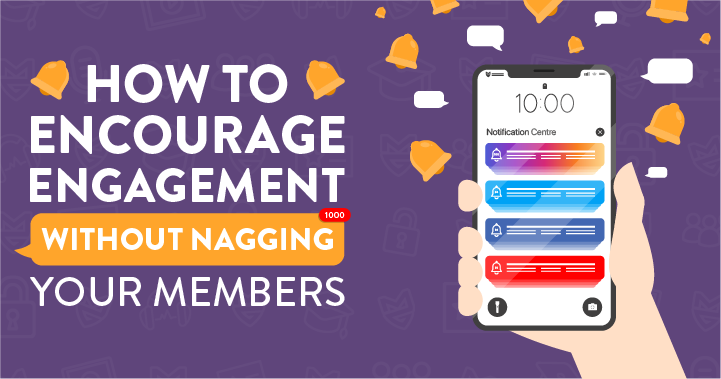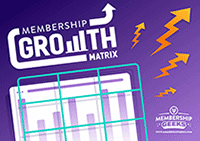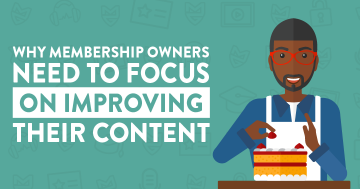There's fine line between encouraging engagement in your membership and simply nagging your members.
The last thing you want to do is get on their nerves…
And sending constant emails reminding them to login to your site will do that.
As membership site owners, we want our members to consume content, interact in the community, and use the membership they pay for…
After all, if they don't, they won't be a member for very long…
But once someone becomes disengaged, your constant messages reminding them what they haven't done won't make them login.
It will most likely have the opposite effect…
And change their view of you and the membership, quickly souring your relationship with them.
There's no doubt about it, member engagement can be tricky to manage.
Yes, you should remind members about new content, or to log in, or finish their course, but you need to do it in the right way.
So, how can you encourage engagement without alienating your members?
Here are some of our top tips…
1. Remove members from your general email list
Often people who join your membership will, at some point, have subscribed to your general email marketing list.
When someone becomes a member, you should remove them from that list immediately.
Because if someone receives two emails from you this week about your blog, another one on your latest sales promotion, then one on the latest additions to your membership…
Any automated reminder emails you send, nudging them to login or complete a course they started, is going to get lost…
And annoy them…
Because it's just adding to the noise.
That's why you should make sure you unsubscribe members from this mailing list and reduce the volume of communication they receive from you…
So the signal to noise ratio works better in your favor.
This will hopefully stop people defaulting into the mode of ‘not another email,’ or filtering your email out and never reading it.
By reducing the amount of email noise going to that member, you increase the likelihood that engagement prompt emails get noticed.
2. Don’t go overboard with your onboarding
As part of your new member onboarding sequence, you'll typically send emails encouraging them to take certain first steps in your community.
If you want those messages to get through, don't bombard them with dozens of emails in their first week.

If you do, the new member will begin to feel overwhelmed and most likely fall behind…
This will result in them not reading all of the emails and missing the really important ones.
Also because of the overwhelm, they might not get into the habit of using your site, logging in, and joining in with the community at all.
That's not the ideal way for them to start their membership experience with you!
Having a specific email strategy for your new members is vital for starting the habit of them being engaged with your site and ensuring they never feel overwhelmed.
3. Use ‘tagging' to shield members from too much email noise
When using an email marketing CRM (Customer Relationship Management) tool, you can use tagging to create a “buffer” around the emails that you send.
So on platforms like:
- ActiveCampaign,
- ConvertKit,
- Keap (Infusionsoft),
- Ontraport, or
- MailChimp…
You can create a no-fly zone around certain members to prevent them receiving multiple messages at once.
This reduces the risk of them becoming annoyed and ignoring your emails.
Here at the Membership Academy, when we send important emails to members – like log-in prompts or onboarding messages for example – and we don’t want that message to get missed, we use a tag to exclude that person from any other emails that are sent the day before and the day after.
So the steps on our automation go a little like this:
- Add a tag “no-other-emails”
- Wait 1 day
- Send important email
- Wait 1 day
- Remove tag “no-other-emails”
Then you can set any messages you send out to your general member base – day to day updates, weekly roundups, content announcements etc – to go out to everyone except those members with the ‘no-other-emails’ tag.
Tagging within a CRM platform to create a buffer can work really well and clear up some of the other noise to make sure the important messages get through free of distraction.
4. Use time-based settings in messaging tools to reduce overwhelm
If you're using a system like Intercom or Drift to send messages about new content and reminders, be careful not to let those messages stack up.
You don’t want someone to log into your site after a three week break to find a huge pile of notifications from you.

This is not a good way to convince someone to re-engage in your site and may push them to leave.
Use time-based settings in your in-app messaging tool to set specific conditions on a message.
For example, you could apply a 2 day time setting for members who haven't logged in to your site so they receive a message…
But only within the time frame you've set.
If they don't login within that time frame, but login after the 2 days, they won't receive the message.
Applying these time limit settings in Intercom and Drift will help to stop the build-up of these nagging messages.
5. Use soft unsubscribe links
Usually, if someone doesn’t want to get emails from you, the only option they have is to click the unsubscribe link at the bottom of one of your emails.
But if they're a member, you really don’t want them to do this, because there will be emails they need to see…
But, if every other day they are being bombarded with emails saying…
‘Hey we noticed you started a course and haven’t logged in for a few days, why not come back to the site?,’ or…
‘Hey, we've noticed you haven't been in the community recently'…
It takes just one of those emails to annoy them and make them hit unsubscribe.
That would mean they'll miss important emails in the future.
Alternatively you can give them the option of soft unsubscribe.
To do this, you need a tag-based email CRM.
Let’s use ActiveCampaign as an example…
When you create a reminder/login email, you have the option of adding a link to the text which states:
‘If you don’t want to receive these kinds of reminders from us, simply click this link to stop getting them.’
The member can then click that link and request to stop receiving that particular type of email.
Your CRM will acknowledge that link has been clicked, and allows you to adds the tag like ‘no-login-reminders’ to that member account.
That means in the future you can create a this automated campaign that excludes anyone who has the tag ‘no-login-reminders'
If your member hasn’t logged in due to a change of circumstances or a personal issue, then giving them a soft unsubscribe reduces the risk of you annoying them.
Giving members the option to selectively stop certain messages can be a much better compromise than having them unsubscribe from everything you send out.
6. Mix up your reminder formats with messaging and ads
You don’t have to always send reminders via email…
You could add Facebook Messenger into your re-engagement mix.
This means you're not always showing up in your member's inbox.
It also has the added benefit that when you do send them important email prompts to get re-engaged, that email doesn’t get lost…
So they're more likely to read it and action it.
You could also think about using Facebook remarketing or Google remarketing ads.
These ads can be tailored so that they're shown to members based on how long it's been since they visited a page of your website.
With really clever targeting, you can even show ads to people who haven’t logged in for a while or people who started a course and didn’t finish it.
To keep things simple, consider using remarketing ads to promote your new content, upcoming training, or a Q&A session.
These may be announcements that you may typically send by email but may work much better as an ad.
So try mixing your reminder messaging and use different formats and strategies.
Just one of them might do the trick and get them to log in, rejoin the community, or finish that course.
7. Don’t overdo your reminders
Are you sending the same reminder email over and over again?
If someone hasn’t responded or followed through, don’t keep constantly reaching out to them and nagging them…
Make sure that your email automation software knows where to stop.
Instead, try creating different emails and take different angles.
Perhaps the first email is, ‘Hey, we noticed this, let us know how you’re getting on.’
Then a week or so later, the next email could be, ‘Hey we miss you.’
Then draw a line…
If they still haven’t taken action after that second email, set an automation to stop further emails being sent to that member.
You should also be mindful that a member may be receiving multiple emails from you…
For example, if they start three separate courses, they may then receive three separate reminders from you…
That's a lot of emails…
Use your automation software to create rules that reduce that email overwhelm.
As membership owners, you should always be aware of the bigger picture.
Your members may have personal reasons for not finishing that course or logging in and having your haranguing them with emails will have the opposite effect.
Take a step back and make sure that you’re not going overboard.
8. Keep in mind that not everyone will engage in the way you want
Don't make assumptions about what engagement is and isn't acceptable in your membership…
Not everyone will have the level of engagement you expect.
For example, you might have someone who logs in and consumes courses every single day, but they may never participate in your community.
That is still engagement.
A lot of membership owners base how engaged their members are by activity in the community…
However, the vast majority of members will not be visible in the community.
But if you believe that the most important sign of engagement is community participation, then your perception could lead you down the path of nagging members…
The member in question might be highly engaged in other parts of your membership, but these are areas that you’re not prioritizing.
Just remember, your idea of engagement may not be the same as your members.
It’s the 90-9-1 rule that we talk about a lot here at the Membership Academy.
This is a rule of thumb that in any given community 1% will be power users who show up several times a day, start conversations, and typically the first to respond to threads.
They are your power users.
About 9% will be regular users.
They’ll maybe show up every other day or a few times a week.
They’ll reply to conversations rather than start them.
You'll know who they are…
Then you have the other 90% who are either lurkers or occasional users…
They might be logging in daily, but they’re not replying…
Yet, they're still getting masses of value from reading the conversations that are happening.
Some of the 90% won't take part in your community at all, but it doesn't mean that they are not engaged elsewhere and that they're the wrong type of member.
If you have some lurkers and members, they're still getting value.
Just because they don’t meet the characteristics of what you feel is engagement doesn’t mean they aren’t engaging.
By readjusting your perception, you'll make sure you don’t accost members for not engaging when in fact they are perfectly happy.
Stay on the right side of the line…
When it comes to member engagement, there's a lot communication involved in…
- Following up with members who haven't logged in for a while
- Nudging people to complete content that they may have started
- Reminding them about what's going on the community, and…
- Keeping them informed on what's happening inside the membership…
It's a balancing act…
But staying on the right side of the line of keeping people informed and giving them a nudge when they need it…
Versus endless emails and becoming annoying…
Is something every membership site owner needs to be mindful of.
That's why you need a carefully thought out engagement strategy that entices your members to interact in your community in the way they want to, rather than accosting them until they cancel their membership altogether.
Hopefully the tips outlined in this blog will help you achieve that.






